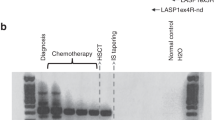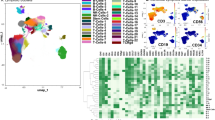Abstract
We have retrospectively investigated the relationship between the level of minimal residual disease (MRD) detected in bone marrow taken prior to conditioning therapy and outcome following stem cell transplantation for high risk childhood ALL. Forty-one patients, in whom both a molecular marker of MRD and sufficient archival material was available, were included in the study. All were in remission at BMT: eight in CR1, 32 in CR2 and five in greater than CR2. MRD was measured by PCR amplification of antigen receptor gene rearrangements and clone-specific oligoprobing, the median sensitivity of detection being one leukaemic cell in 10000 normals. Results were classified as high-level positive (if a clonal band was evident after electrophoresis), low-level positive (if MRD was detected only after oligoprobing) and negative. MRD was detected at high levels in 17 patients, at low levels in 10 patients and 14 patients were MRD negative at the time of transplant. The 5-year event-free survival for these groups was 23%, 48% and 78%, respectively (P = 0.022). Limited multivariate analysis confirmed the significance of MRD (P = 0.0095) vs CR status, donor type, sex, immunophenotype and acute GvHD. This study confirms the strong relationship between MRD level and outcome following allogeneic transplantation. In contrast to a previous study we observed that a minority of children with high-level pre-BMT MRD can enter long lasting remission. The possible role for acute GVHD coupled with a graft-versus-leukaemia effect in the clearance of high level MRD in patients with ALL is discussed.
This is a preview of subscription content, access via your institution
Access options
Subscribe to this journal
Receive 12 print issues and online access
$259.00 per year
only $21.58 per issue
Buy this article
- Purchase on Springer Link
- Instant access to full article PDF
Prices may be subject to local taxes which are calculated during checkout


Similar content being viewed by others
References
Uckun FM, Kersey JH, Haake R, Weisdorf D, Nesbit ME, Ramsay NK . Pretransplantation burden of leukemic progenitor cells as a predictor of relapse after bone marrow transplantation for acute lymphoblastic leukemia N Engl J Med 1993 329: 1296–1301
Knechtli CJ, Goulden NJ, Hancock JP, Grandage VL, Harris EL, Garland RJ, Jones CG, Rowbottom AW, Hunt LP, Green AF, Clarke E, Lankester AW, Cornish JM, Pamphilon DH, Steward CG, Oakhill A . Minimal residual disease status before allogeneic bone marrow transplantation is an important determinant of successful outcome for children and adolescents with acute lymphoblastic leukemia Blood 1998 92: 4072–4079
Uzunel M, Mattsson J, Jaksch M, Remberger M, Ringden O . The significance of graft-versus-host disease and pretransplantation minimal residual disease status to outcome after allogeneic stem cell transplantation in patients with acute lymphoblastic leukemia Blood 2001 98: 1982–1984
van der Velden VH, Joosten SA, Willemse MJ, van Wering ER, Lankester AW, van Dongen JJ, Hoogerbrugge PM . Real-time quantitative PCR for detection of minimal residual disease before allogeneic stem cell transplantation predicts outcome in children with acute lymphoblastic leukemia Leukemia 2001 9: 1485–1487
Bene MC, Castoldi G, Knapp W, Ludwig WD, Matutes E, Orafo A, van't Veer MB . Proposals for the immunological classification of acute leukemias Leukemia 1995 9: 1783–1786
Handgretinger R, Schumm M, Lang P, Greil J, Reiter A, Bader P, Niethammer D, Klingebiel T . Transplantation of megadoses of purified haploidentical stem cells Ann NY Acad Sci 1999 872: 351–361
Glucksberg H, Storb R, Fefer A, Buckner CD, Neiman PE, Clift RA, Lerner KG, Thomas ED . Clinical manifestations of graft-versus-host disease in human recipients of marrow from HL-A-matched sibling donors Transplantation 1974 18: 295–304
Klingebiel T, Schlegel PG . GVHD: overview on pathophysiology, incidence, clinical and biological features Bone Marrow Transplant 1998 21 (Suppl. 2): S45–S49
Goulden NJ, Knechtli CJ, Garland RJ, Langlands K, Hancock JP, Potter MN, Steward CG, Oakhill A . Minimal residual disease analysis for the prediction of relapse in children with standard-risk acute lymphoblastic leukaemia Br J Haematol 1998 100: 235–244
Bader P, Klingebiel T, Schaudt A, Theurer-Mainka U, Handgretinger R, Lang P, Niethammer D, Beck JF . Prevention of relapse in pediatric patients with acute leukemias and MDS after allogeneic SCT by early immunotherapy initiated on the basis of increasing mixed chimerism: a single center experience of 12 children Leukemia 1999 13: 2079–2086
Bader P, Stoll K, Huber A, Geiselhart A, Handgretinger R, Niemeyer C, Einsele H, Schlegel PG, Niethammer D, Beck J, Klingebiel T . Characterization of lineages specific chimerism in patients with acute leukemia and MDS after allogeneic SCT before and after relapse Br J Haematol 2000 4: 761–769
Barrett AJ, Horowitz MM, Pollock BH, Zhang MJ, Bortin MM, Buchanan GR, Camitta BM, Ochs J, Graham-Pole J, Rowlings PA . Bone marrow transplants from HLA-identical siblings as compared with chemotherapy for children with acute lymphoblastic leukemia in a second remission N Engl J Med 1994 331: 1253–1258
Chessells JM, Rogers DW, Leiper AD, Blacklock H, Plowman PN, Richards S, Levinsky R, Festenstein H . Bone-marrow transplantation has a limited role in prolonging second marrow remission in childhood lymphoblastic leukaemia Lancet 1986 1: 1239–1241
Pongers Willemse MJ, Verhagen OJ, Tibbe GJ, Wijkhuijs AJ, de Haas V, Roovers E, van der Schoot CE, van Dongen JJM . Real-time quantitative PCR for the detection of minimal residual disease in acute lymphoblastic leukemia using junctional region specific TaqMan probes Leukemia 1998 12: 2006–2014
Verhagen OJHM, Willemse MJ, Breunis WB, Wijkhuijs AJM, Jacobs DCH, Joosten SA, van Wering ER, van Dongen JJM, van der Shoot CE . Application of germline IGH probes in real-time quantitative PCR for the detection of minimal residual disease in acute lymphoblastic leukemia Leukemia 2000 14: 1426–1435
Szczepanski T, Beishuizen A, Pongers-Willemse MJ, Kählen K, Van Wering ER, Wijkhuijs AJM, Tibbe GJM, De Bruijn MAC, van Dongen JJM . Cross-lineage T cell receptor gene rearrangements occur in more than ninety percent of childhood precursor-B acute lymphoblastic leukemias: alternative PCR targets for detection of minimal residual disease Leukemia 1999 13: 196–205
de Hass V, Verhagen OJHM, von dem Borne AEGK, Kroes W, van den Berg H, van der Schoot CE . Quantification of minimal residual disease in children with oligoclonal B-precursor acute lymphoblastic leukemia indicates that the clones that grow out during relapse already have the lowest rate of reduction during induction therapy Leukemia 2001 15: 134–140
Acknowledgements
This study was supported by the Fortüne research fund of the University of Tübingen and the Wilhelm-Sander-Foundation (98.030.1).
Author information
Authors and Affiliations
Rights and permissions
About this article
Cite this article
Bader, P., Hancock, J., Kreyenberg, H. et al. Minimal residual disease (MRD) status prior to allogeneic stem cell transplantation is a powerful predictor for post-transplant outcome in children with ALL. Leukemia 16, 1668–1672 (2002). https://doi.org/10.1038/sj.leu.2402552
Received:
Accepted:
Published:
Issue Date:
DOI: https://doi.org/10.1038/sj.leu.2402552
Keywords
This article is cited by
-
Predictors of hematologic malignancy relapse in patients with advanced chronic graft-versus-host disease
Bone Marrow Transplantation (2021)
-
IgH gene rearrangement by PCR as an adjunct to flow cytometric analysis for the detection of minimal residual disease in patients with B lymphoblastic leukemia
Journal of Hematopathology (2020)
-
Measurable residual disease at myeloablative allogeneic transplantation in adults with acute lymphoblastic leukemia: a retrospective registry study on 2780 patients from the acute leukemia working party of the EBMT
Journal of Hematology & Oncology (2019)
-
Standardisation and consensus guidelines for minimal residual disease assessment in Philadelphia-positive acute lymphoblastic leukemia (Ph + ALL) by real-time quantitative reverse transcriptase PCR of e1a2 BCR-ABL1
Leukemia (2019)
-
Influence of pre-transplant minimal residual disease on prognosis after Allo-SCT for patients with acute lymphoblastic leukemia: systematic review and meta-analysis
BMC Cancer (2018)



